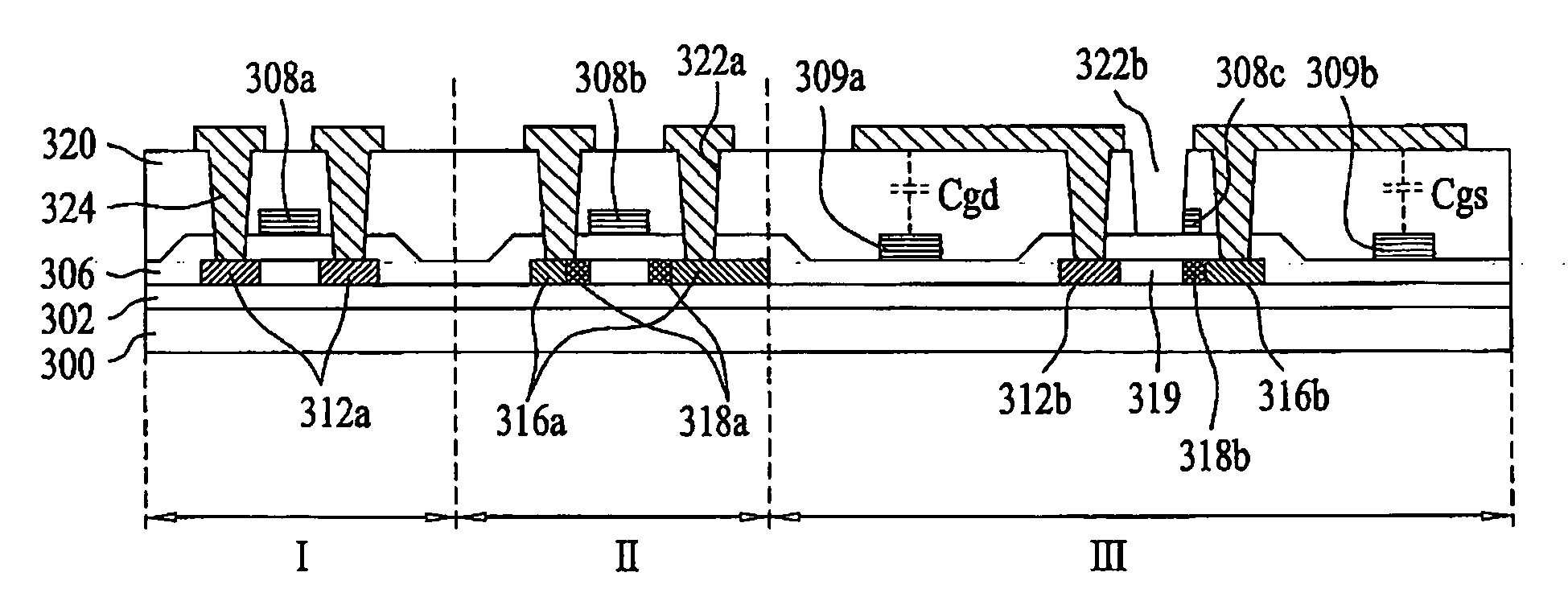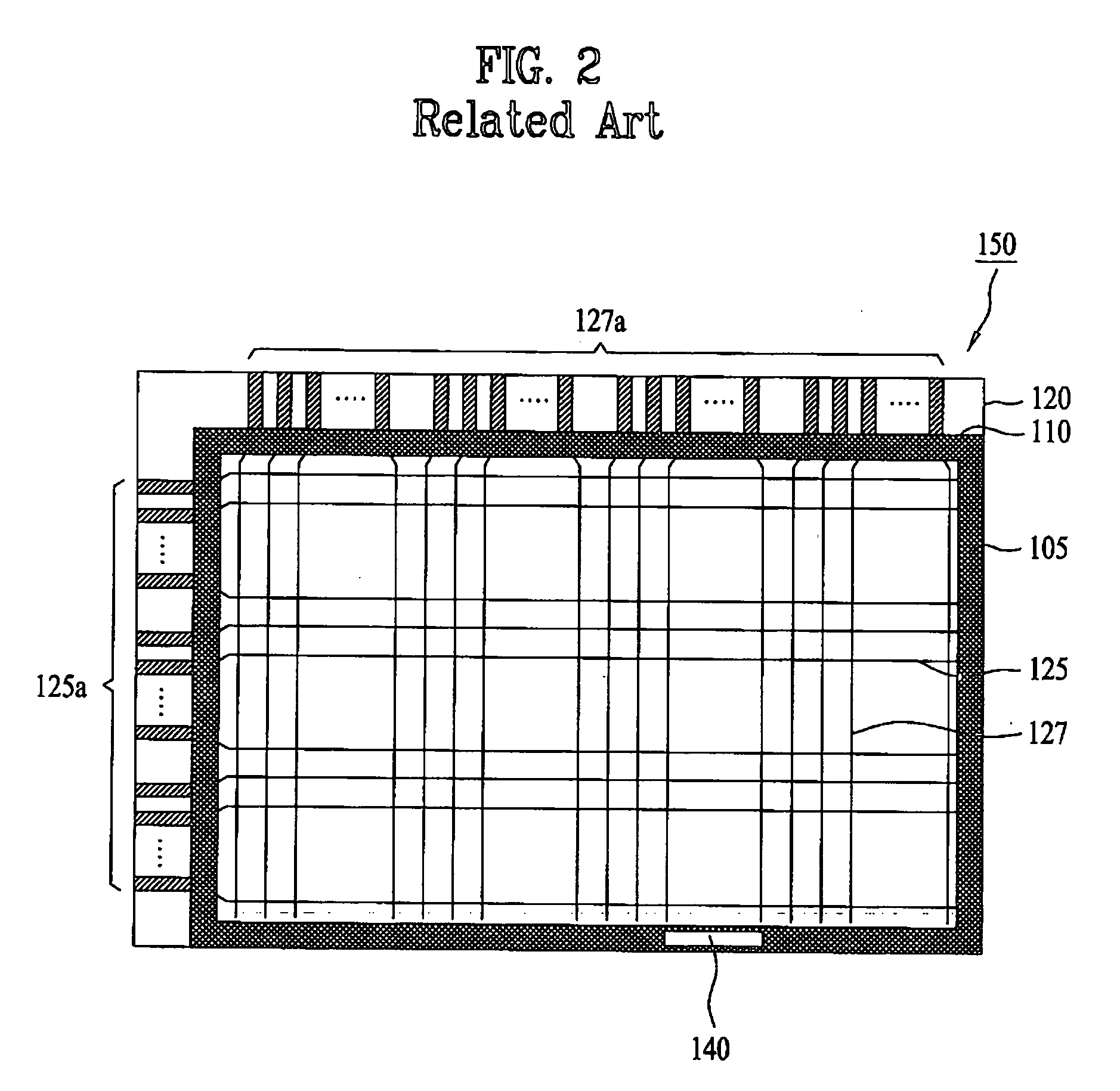Liquid crystal display with photosensor and method of fabricating the same
a technology of photosensors and liquid crystal displays, applied in semiconductor devices, instruments, electrical devices, etc., can solve problems such as power consumption increase, and achieve the effect of improving sensing efficiency
- Summary
- Abstract
- Description
- Claims
- Application Information
AI Technical Summary
Benefits of technology
Problems solved by technology
Method used
Image
Examples
first embodiment
[0059]FIG. 5 is a cross section view illustrating a photosensor region and a thin film transistor region in a liquid crystal display device including a photosensor according to the present invention.
[0060]As shown in FIG. 5, a substrate 300 is defined with a first thin film transistor region (I) having a channel by a p-type ion implantation region; a second thin film transistor region (II) having a channel by an n-type ion implantation region; and a photosensor region (III).
[0061]The first thin film transistor region (I) includes a p-type semiconductor layer provided with two p-type ion implantation regions 312a on a buffer layer 302, and an ion non-implantation region formed between the two p-type ion implantation regions 312a; a gate insulation film 306 formed on the substrate 300 including the p-type semiconductor layer; a gate electrode 308a formed on the gate insulation film 306 above the ion non-implantation region; a passivation film 320 on an entire surface of the substrate ...
second embodiment
[0090]FIGS. 8A to 8C are cross section views illustrating a method of fabricating a liquid crystal display device with a photosensor according to the present invention.
[0091]First, LDD layers 318a and 318b are formed through the steps explained in FIGS. 6A and 6D according to the first embodiment of the present invention.
[0092]Subsequently, as shown in FIG. 8A, a passivation film 320 is formed on an entire surface of a substrate 300 including the LDD layers 318a and 318b, and is then patterned, thereby forming first and second contact holes 322a and 322c at the same time. At this time, the first contact hole 322a exposes semiconductor layers of source and drain regions 312a and 316a in respective first and second thin film transistor regions (I) and (II). Also, the second contact hole 322c exposes an ion implanting prevention film 308c of a photosensor region (III).
[0093]As shown in FIG. 8B, a metal film 324 is formed on the entire surface of the substrate 300 including the first an...
third embodiment
[0096]The first and second preferred embodiments of the present invention disclose that the ion implanting prevention film 308c is removed completely. The following discloses a method of fabricating a liquid crystal display device including a photosensor according to the present invention where only the central portion of the ion implanting prevention film 308c is removed.
[0097]FIGS. 9A and 9B are cross section views illustrating a method of fabricating a liquid crystal display device with a photosensor according to the third embodiment of the present invention.
[0098]First, LDD layers 318a and 318b are formed through the steps of FIGS. 6A to 6D explaining the first embodiment of the present invention.
[0099]Subsequently, as shown in FIG. 9A, a passivation film 320 is formed on an entire surface of a substrate 300 including the LDD layers 318a and 318b, and is then patterned, thereby forming first and second contact holes 322a and 322d at the same time. At this time, the first contact...
PUM
| Property | Measurement | Unit |
|---|---|---|
| time | aaaaa | aaaaa |
| time | aaaaa | aaaaa |
| weight | aaaaa | aaaaa |
Abstract
Description
Claims
Application Information
 Login to View More
Login to View More - R&D
- Intellectual Property
- Life Sciences
- Materials
- Tech Scout
- Unparalleled Data Quality
- Higher Quality Content
- 60% Fewer Hallucinations
Browse by: Latest US Patents, China's latest patents, Technical Efficacy Thesaurus, Application Domain, Technology Topic, Popular Technical Reports.
© 2025 PatSnap. All rights reserved.Legal|Privacy policy|Modern Slavery Act Transparency Statement|Sitemap|About US| Contact US: help@patsnap.com



